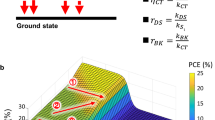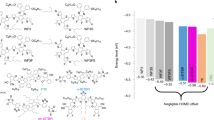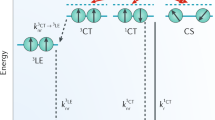Abstract
Fast and efficient charge separation is essential to achieve high power conversion efficiency in organic solar cells (OSCs). In state-of-the-art OSCs, this is usually achieved by a significant driving force, defined as the offset between the bandgap (Egap) of the donor/acceptor materials and the energy of the charge transfer (CT) state (ECT), which is typically greater than 0.3 eV. The large driving force causes a relatively large voltage loss that hinders performance. Here, we report non-fullerene OSCs that exhibit ultrafast and efficient charge separation despite a negligible driving force, as ECT is nearly identical to Egap. Moreover, the small driving force is found to have minimal detrimental effects on charge transfer dynamics of the OSCs. We demonstrate a non-fullerene OSC with 9.5% efficiency and nearly 90% internal quantum efficiency despite a low voltage loss of 0.61 V. This creates a path towards highly efficient OSCs with a low voltage loss.
This is a preview of subscription content, access via your institution
Access options
Subscribe to this journal
Receive 12 digital issues and online access to articles
$119.00 per year
only $9.92 per issue
Buy this article
- Purchase on Springer Link
- Instant access to full article PDF
Prices may be subject to local taxes which are calculated during checkout




Similar content being viewed by others
References
Sariciftci, N. S., Smilowitz, L., Heeger, A. J. & Wudl, F. Photoinduced electron transfer from a conducting polymer to buckminsterfullerene. Science 258, 1474–1476 (1992).
Yu, G., Gao, J., Hummelen, J. C., Wudl, F. & Heeger, A. J. Polymer photovoltaic cells: enhanced efficiencies via a network of internal donor-acceptor heterojunctions. Science 270, 1789–1791 (1995).
Heeger, A. J. 25th anniversary article: bulk heterojunction solar cells: understanding the mechanism of operation. Adv. Mater. 26, 10–27 (2014).
Guo, X. et al. Polymer solar cells with enhanced fill factors. Nature Photon. 7, 825–833 (2013).
He, Z. et al. Enhanced power-conversion efficiency in polymer solar cells using an inverted device structure. Nature Photon. 6, 593–597 (2012).
Liu, Y. et al. Aggregation and morphology control enables multiple cases of high-efficiency polymer solar cells. Nature Commun. 5, 5293 (2014).
Vohra, V. et al. Efficient inverted polymer solar cells employing favourable molecular orientation. Nature Photon. 9, 403–408 (2015).
Yao, J. et al. Quantifying losses in open-circuit voltage in solution-processable solar cells. Phys. Rev. Appl. 4, 014020 (2015).
Vandewal, K., Tvingstedt, K., Gadisa, A., Inganäs, O. & Manca, J. V. Relating the open-circuit voltage to interface molecular properties of donor:acceptor bulk heterojunction solar cells. Phys. Rev. B 81, 125204 (2010).
Vandewal, K., Tvingstedt, K., Gadisa, A., Inganas, O. & Manca, J. V. On the origin of the open-circuit voltage of polymer-fullerene solar cells. Nature Mater. 8, 904–909 (2009).
Burke, T. M., Sweetnam, S., Vandewal, K. & McGehee, M. D. Beyond Langevin recombination: how equilibrium between free carriers and charge transfer states determines the open-circuit voltage of organic solar cells. Adv. Energy Mater. 5, 1500123 (2015).
Tvingstedt, K. et al. Electroluminescence from charge transfer states in polymer solar cells. J. Am. Chem. Soc. 131, 11819–11824 (2009).
Heumueller, T. et al. Disorder-induced open-circuit voltage losses in organic solar cells during photoinduced burn-in. Adv. Energy Mater. 5, 1500111 (2015).
Vandewal, K. et al. Efficient charge generation by relaxed charge-transfer states at organic interfaces. Nature Mater. 13, 63–68 (2014).
Scharber, M. C. et al. Design rules for donors in bulk-heterojunction solar cells—towards 10% energy-conversion efficiency. Adv. Mater. 18, 789–794 (2006).
Li, W., Hendriks, K. H., Furlan, A., Wienk, M. M. & Janssen, R. A. High quantum efficiencies in polymer solar cells at energy losses below 0.6 eV. J. Am. Chem. Soc. 137, 2231–2234 (2015).
Vandewal, K. et al. Quantification of quantum efficiency and energy losses in low bandgap polymer: fullerene solar cells with high open-circuit voltage. Adv. Funct. Mater. 22, 3480–3490 (2012).
Wang, M. et al. High open circuit voltage in regioregular narrow band gap polymer solar cells. J. Am. Chem. Soc. 136, 12576–12579 (2014).
Jung, J. W., Liu, F., Russell, T. P. & Jo, W. H. Semi-crystalline random conjugated copolymers with panchromatic absorption for highly efficient polymer solar cells. Energy Environ. Sci. 6, 3301–3307 (2013).
Peng, Q. et al. Enhanced solar cell performance by replacing benzodithiophene with naphthodithiophene in diketopyrrolopyrrole-based copolymers. Chem. Commun. 48, 11452–11454 (2012).
Ran, N. A. et al. Harvesting the full potential of photons with organic solar cells. Adv. Mater. 28, 1482–1488 (2016).
Ma, Z., Wang, E., Vandewal, K., Andersson, M. R. & Zhang, F. Enhance performance of organic solar cells based on an isoindigo-based copolymer by balancing absorption and miscibility of electron acceptor. Appl. Phys. Lett. 99, 143302 (2011).
Kawashima, K., Tamai, Y., Ohkita, H., Osaka, I. & Takimiya, K. High-efficiency polymer solar cells with small photon energy loss. Nature Commun. 6, 10085 (2015).
Sauvé, G. & Fernando, R. Beyond fullerenes: designing alternative molecular electron acceptors for solution-processable bulk heterojunction organic photovoltaics. J. Phys. Chem. Lett. 6, 3770–3780 (2015).
Zhan, X. et al. Rylene and related diimides for organic electronics. Adv. Mater. 23, 268–284 (2011).
Zhong, Y. et al. Molecular helices as electron acceptors in high-performance bulk heterojunction solar cells. Nature Commun. 6, 8242 (2015).
Chen, Z. et al. Low band-gap conjugated polymers with strong interchain aggregation and very high hole mobility towards highly efficient thick-film polymer solar cells. Adv. Mater. 26, 2586–2591 (2014).
Mao, Z. et al. Azadipyrromethene-based Zn(II) complexes as nonplanar conjugated electron acceptors for organic photovoltaics. Adv. Mater. 26, 6290–6294 (2014).
Zhao, J. et al. High-efficiency non-fullerene organic solar cells enabled by a difluorobenzothiadiazole-based donor polymer combined with a properly matched small molecule acceptor. Energy Environ. Sci. 8, 520–525 (2015).
Lin, H. et al. High-performance non-fullerene polymer solar cells based on a pair of donor–acceptor materials with complementary absorption properties. Adv. Mater. 27, 7299–7304 (2015).
Sun, D. et al. Non-fullerene-acceptor-based bulk-heterojunction organic solar cells with efficiency over 7%. J. Am. Chem. Soc. 137, 11156–11162 (2015).
Lin, Y. et al. An electron acceptor challenging fullerenes for efficient polymer solar cells. Adv. Mater. 27, 1170–1174 (2015).
Shockley, W. & Queisser, H. J. Detailed balance limit of efficiency of p–n junction solar cells. J. Appl. Phys. 32, 510–519 (1961).
Shivanna, R. et al. Charge generation and transport in efficient organic bulk heterojunction solar cells with a perylene acceptor. Energy Environ. Sci. 7, 435–441 (2014).
Deshmukh, K. D. et al. Performance, morphology and photophysics of high open-circuit voltage, low band gap all-polymer solar cells. Energy Environ. Sci. 8, 332–342 (2015).
Chen, K., Barker, A. J., Reish, M. E., Gordon, K. C. & Hodgkiss, J. M. Broadband ultrafast photoluminescence spectroscopy resolves charge photogeneration via delocalized hot excitons in polymer: fullerene photovoltaic blends. J. Am. Chem. Soc. 135, 18502–18512 (2013).
Gélinas, S. et al. Ultrafast long-range charge separation in organic semiconductor photovoltaic diodes. Science 343, 512–516 (2014).
Jamieson, F. C. et al. Fullerene crystallisation as a key driver of charge separation in polymer/fullerene bulk heterojunction solar cells. Chem. Sci. 3, 485–492 (2012).
Sweetnam, S. et al. Characterization of the polymer energy landscape in polymer: fullerene bulk heterojunctions with pure and mixed phases. J. Am. Chem. Soc. 136, 14078–14088 (2014).
Gregg, B. A. Entropy of charge separation in organic photovoltaic cells: the benefit of higher dimensionality. J. Phys. Chem. Lett. 2, 3013–3015 (2011).
van Eersel, H., Janssen, R. A. J. & Kemerink, M. Mechanism for efficient photoinduced charge separation at disordered organic heterointerfaces. Adv. Funct. Mater. 22, 2700–2708 (2012).
Hexemer, A. et al. A SAXS/WAXS/GISAXS beamline with multilayer monochromator. J. Phys. Conf. Ser. 247, 012007 (2010).
Gann, E. et al. Soft X-ray scattering facility at the Advanced Light Source with real-time data processing and analysis. Rev. Sci. Instrum. 83, 045110 (2012).
Acknowledgements
The work described in this paper was partially supported by the National Basic Research Program of China (973 Program; 2013CB834701 and 2014CB643501), the Hong Kong Research Grants Council (T23–407/13 N, N_HKUST623/13, and 606012), HK JEBN Limited, and the National Science Foundation of China (nos 21374090 and 51361165301). X-ray characterization by NCSU was supported by the Office of Naval Research (award nos N000141410531 and N000141512322). Ultrafast spectroscopy work at NCSU was supported by Office of Naval Research (award no N000141310526 P00002). X-ray data were acquired at beamline 7.3.3 and 11.0.1.2 at the Advanced Light Source, which was supported by the Director, Office of Science, Office of Basic Energy Sciences, of the US Department of Energy under contract no. DE-AC02–05CH11231. The research at Linköping is financially supported by the Swedish Research Councils (VR, grant no. 330-2014-6433 and FORMAS, grant no. 942-2015-1253), the Swedish Government Strategic Research Area in Materials Science on Functional Materials at Linköping University (faculty grant SFO-Mat-LiU # 2009-00971), the European Commission Marie Skłodowska-Curie actions (grant nos 691210 and INCA 600398), and a Wallenberg Scholar grant to O.I.
Author information
Authors and Affiliations
Contributions
J.L. and S.C. contributed equally to this work. J.L. synthesized the polymer and carried out the cyclic voltammetry, atomic force microscopy, transmission electron microscopy and PL characterizations; S.C. fabricated the solar cell devices and carried out ultraviolet measurements; D.Q. performed the FTPS and EL experiments supervised by F.G.; G.Y. analysed the GIWAXS and R-SoXS data supervised by W.M.; B.G. performed the TAS experiments supervised by K.G.; J.B. carried out the IQE measurement; J.Z., F.Z., H.A. and O.I. helped in the data interpretation. H.Y., F.G., J.L., S.C. and J.Z. wrote the manuscript; H.Y. conceived and directed the project; all authors discussed the results and commented on the final manuscript.
Corresponding authors
Ethics declarations
Competing interests
The authors declare no competing financial interests.
Supplementary information
Supplementary Information
Supplementary Note 1, Supplementary Figures 1–35, Supplementary Tables 1–3, Supplementary Methods, Supplementary References. (PDF 2882 kb)
Rights and permissions
About this article
Cite this article
Liu, J., Chen, S., Qian, D. et al. Fast charge separation in a non-fullerene organic solar cell with a small driving force. Nat Energy 1, 16089 (2016). https://doi.org/10.1038/nenergy.2016.89
Received:
Accepted:
Published:
DOI: https://doi.org/10.1038/nenergy.2016.89
This article is cited by
-
Rational molecular and device design enables organic solar cells approaching 20% efficiency
Nature Communications (2024)
-
Physical insights into non-fullerene organic photovoltaics
Nature Reviews Physics (2024)
-
Origins of the open-circuit voltage in ternary organic solar cells and design rules for minimized voltage losses
Nature Energy (2023)
-
Driving force and nonequilibrium vibronic dynamics in charge separation of strongly bound electron–hole pairs
Communications Physics (2023)
-
Models and mechanisms of ternary organic solar cells
Nature Reviews Materials (2023)



